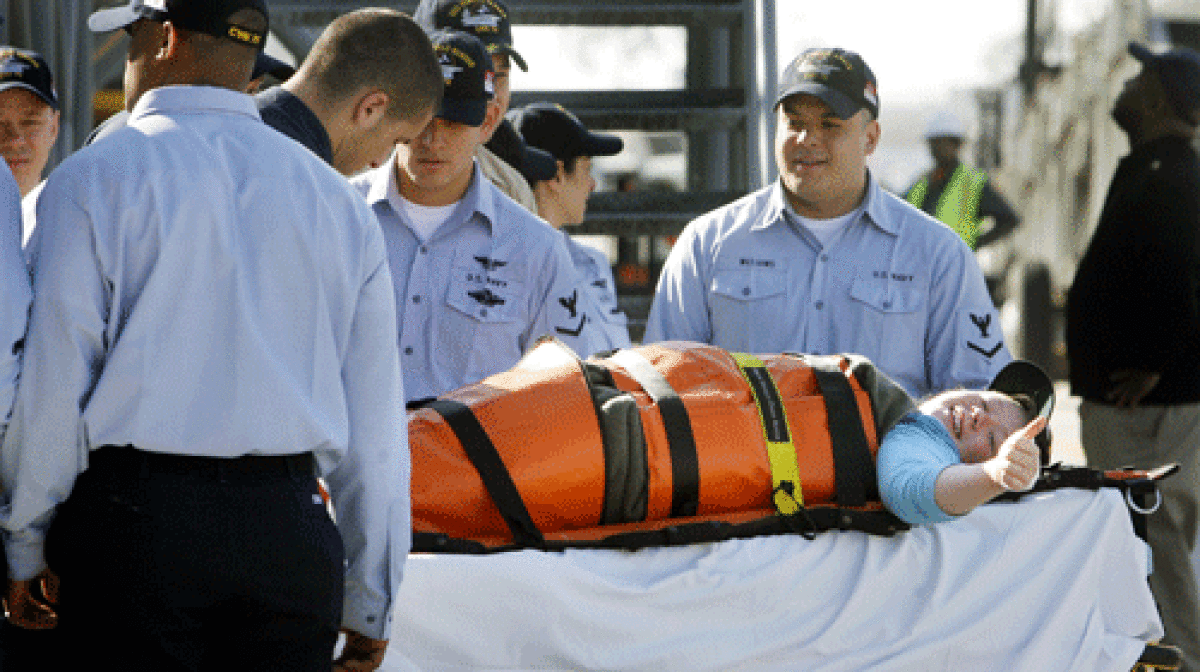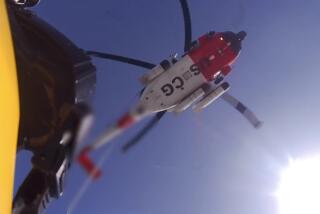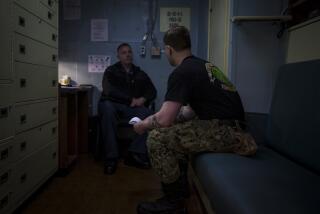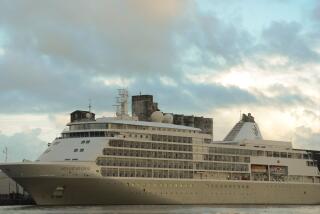Navy comes to aid of girl in distress on cruise ship

SAN DIEGO -- Fourteen-year-old Laura Montero was aboard a cruise ship off Baja California late last week when her appendix ruptured, causing her agonizing pain.
The Dawn Princess was out at sea. The ship doctor lacked the anesthesia for an appendectomy.
The teenager from rural Illinois had been enjoying a vacation with 15 members of her family. Now Laura’s mother, Trudy Lafield, began to worry that their long-awaited holiday idyll on the Mexican Riviera would prove fatal.
Then, 550 miles away, the aircraft carrier Ronald Reagan, on a training mission in preparation for deployment to the Persian Gulf, answered a distress call.
At dawn Saturday, the carrier dispatched a rescue helicopter. Onboard were a doctor and search-and-rescue sailors trained to pluck downed pilots from the ocean.
A problem became clear immediately: The cruise ship didn’t have a deck big enough for the Seahawk helicopter to land.
Instead, the big chopper would have to hover and hoist Laura up in a stretcher-basket before taking her back to the carrier for medical treatment.
The cruise ship, meanwhile, would have to position itself so the wind would give the helicopter maximum lift -- a tricky maneuver even for a skipper accustomed to helicopter landings.
“We needed the Princess to angle more to get us the best winds possible,” said Lt. Cmdr. Gregory Leland, the helicopter pilot.
It did.
“The captain did great,” Leland said.
Navy corpsman Scott Heintschel, part of Helicopter Anti-Submarine Squadron 4, was lowered to the deck first to ensure that the basket was secured for the lift.
Laura’s mother couldn’t watch.
“I was frantic,” said the waitress from Albion, Ill. “I had to go below.”
With the chopper hovering 20 feet off the cruise ship’s deck, the basket with Laura in it was hoisted slowly. Once she was on the helicopter, the basket was lowered again, to pick up Heintschel.
As the helicopter made its way back to the carrier, both the corpsman and the doctor attended to the girl.
“She was hurting,” Heintschel said. “She had had some pain meds, but it’s a rough lift onto the helo. If you have a sore or hot belly, you’re going to feel it.”
By the time the rescue was made, the distance between the two ships had closed to within 50 miles. The flight was quick. As soon as the helicopter landed, Laura was rushed to the surgical ward, where doctors and nurses were waiting.
“She was a very sick girl,” said Cmdr. George Linville, the ship’s surgeon, who performed the appendectomy. “She had gone septic. Untreated for another 24 to 36 hours, it could have been a lot worse.”
Appendectomies aboard ship are not uncommon, he said. Just five days earlier, he had performed one on one of the 6,000 sailors in the Reagan’s crew. Two hours after landing on the carrier, Laura was out of surgery and in recovery. In the days that followed, sailors adopted the teenager, giving her T-shirts, teddy bears and a Reagan hat.
“She was a real rock star on the ship,” said Capt. Terry B. Kraft, the carrier’s commanding officer.
The Dawn Princess finished its eight-day cruise, returning to San Diego on Sunday. Later that day, on one of the regularly scheduled delivery flights, the Navy flew Lafield to join her daughter on the Reagan.
Tuesday morning, the Reagan finished its 20-day training mission, docking at North Island Naval Air Station in Coronado. A waiting ambulance took Laura to Rady Children’s Hospital in San Diego, where she was scheduled to stay overnight.
As sailors carried her gingerly down the 20 steps from the carrier brow to the dock, the teenager waved and gave a thumbs up.
As the ambulance moved slowly away, Laura’s mother hugged Cmdr. Theron Toole, the Reagan’s senior medical officer.
“I’m all for what the Navy does,” Lafield said. “I’m Navy 100%.”
More to Read
Sign up for Essential California
The most important California stories and recommendations in your inbox every morning.
You may occasionally receive promotional content from the Los Angeles Times.










